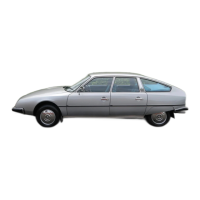C/1
.j.
0
,_.
.--
f-.
r}1
4
OPERATION N° MÅ. 410-0 :
a,t/
(l(fjiiS1ie. !IL
/YL/f e.I.
iiiiii.
III. CHECKING THE CAMBER
ANGLE
NOTE
The camber
angle is not
adjustable.
1.
Prepare
vehicie and set in
position
(s
c/iapters
1 a,id
2
).
2.
Setting up
checking apparotus
Place the apparatus on
the magnetic
support of the
wheel to be
checked.
Use the axis corresponding to the
blue
urroi A..
Keep
the level in
a
horizontal
position.
Tiqhten
locking
screw (1).
3. Checking
the cam ber ongle
IMPORTANT : Check
that the reading
Li has not
ch
onged
s
hnpir 1
).
o)
Tum the disc
(
2)
until
th fixed
spirit-level
bubble (3) is centred.
b)
Note
in
blue sucile
(at
«
a
»
)
the
reading
of
the
camber angle.
c)
Carry out
the same
operation
on
the
other
wheel.
Cc*mber angle must be between 00
+
13'
-
29'
lv. CHECKING
AND ADJUSTING THECASTOR
ANGLE
IMPORTANT For precise
results from this check
it is imperative to set the vehicie
heights
as foliows
165
mm at front and 215
mm at rear
(SaiGmis)
or
228
mm
(
Lzsiates
1.
1. Setting the vehicie
height
a)
Check ineasurements
Li and L2
(see d,apter 1).
b)
Release
pressure
in
suspension system.
2. Setting
control oppartus
Place the apparatus on
the magnetic
bracket
of
the
wheel
to
be checked using
the axis corres-
ponding
to
grcle1 arrwu
B,
3.
Checking castor angle
a)
Tum
wheels 20° outwards
:
to
the lett
for
the
left-hund
wheel
and
to
the right for the ri-qht-
hand wheel.
Keeping the apparatus horizontal tighten locking
screw (1).
b)
Tum the disc (4) until
the aero mark is opposite
arrow
(
at «
b
»
c)
Tum knurled knob (5) until spirit-level
bubble
(6) is
centred.
PDF compression, OCR, web-optimization with CVISION's PdfCompressor

